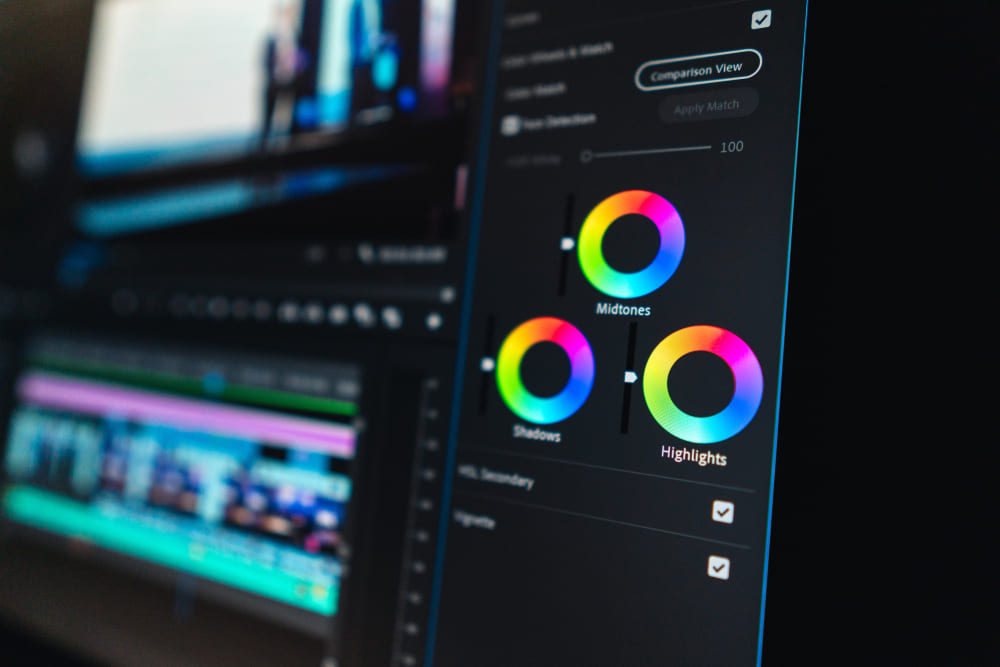What Is Color Grading: Enhancing Visual Media with Colors and Tones
Have you ever watched a movie or looked at a photograph and been struck by how visually stunning it looks? Chances are, the vibrant colors, rich tones, and overall mood that you're seeing are the result of color grading.
It is the process of adjusting the colors, contrast, and brightness of video footage or a photo to create a specific look and feel. It's a crucial step in the post-production process that can make a huge difference in the final product.
Color grading is an essential tool in visual storytelling. It helps to create a specific atmosphere and convey emotion. This enhances the overall impact of a video or photo.
It can help you create a unique visual style for any project, from Hollywood blockbusters to personal photo projects. This style will make your work stand out and captivate viewers.
It is an important part of creating visually stunning photos and videos. In this article, we will explore what is color grading, how it is done, and why it is so important.
So whether you're a professional photographer, videographer, or just someone who loves to capture and create beautiful imagery, get ready to dive into the fascinating world of color grading.

In this article, you will learn:
- What Is Color Grading?
- Is Color Grading Necessary?
- What Is Color Grading in Video?
- What Is Color Grading in Photography?
- Improve Your Efficiency of Color Grading
What Is Color Grading?
Color grading is the process of adjusting the colors, contrast, and brightness of a photo or video to create a specific look and feel. It's like using a filter on Instagram but with much more control and fine-tuning.
In photography, color grading can be used to enhance the mood and atmosphere of a photo. For example, a warm color grading can give a photo a cozy and nostalgic feel, while a cool color grading can create a sense of calmness and tranquility.
In movies, color grading is used to create a specific visual style that complements the story and tone of the film. For example, a movie set in the 1970s might have a color grading that feels warm and slightly desaturated, to give it a vintage look.
A horror movie might have a color grading that's dark and desaturated, to create a sense of tension and unease.
Color grading can also be used in video production, such as in commercials, music videos, and YouTube videos. It can help create a consistent and polished look for the video, and enhance the message and emotion conveyed through the visuals.
Color grading is a powerful tool that can greatly enhance the visual impact of a photo or video. It allows creators to have complete control over the colors, contrast, and brightness, and create a unique and captivating style that sets their work apart.

Is Color Grading Necessary?
Color grading is actually really necessary because it lets photographers and filmmakers adjust the colors and tones in their work to create a specific mood or atmosphere. It's kind of like painting - you choose the colors and shades carefully to achieve a particular effect.
Without color grading, the visual impact of a photo or video might not be as strong, and the desired feeling or mood might not come across as well.
For example, a horror movie might use dark, desaturated colors to create a sense of dread and foreboding. In contrast, a romantic comedy might use bright, warm colors to create a happy and inviting atmosphere.
In photography, color grading can be used to enhance the colors in a landscape photo, making the sky more vibrant and the foliage greener. In portrait photography, color grading can be used to create a certain mood, like making the photo look more vintage or giving it a warm, golden glow.
In movies, color grading is essential to create a consistent look and feel throughout the film.
For example, the movie "The Grand Budapest Hotel" uses a pastel color palette to create a whimsical and nostalgic atmosphere. In contrast, the movie "Mad Max: Fury Road" uses a desaturated color palette to create a gritty and dystopian atmosphere.

Mad Max: Fury Road
What Is Color Grading in Video?
Color grading in the video is the process of adjusting the colors and tones of a video to achieve a specific look or mood. It's like using a filter on a photo, but for an entire video.
Color grading is important because it can completely change the way a video looks and feels. For example, a video set in a post-apocalyptic world might have muted, desaturated colors to create a sense of despair and hopelessness.
On the other hand, a music video might have bright, vibrant colors to create a fun and energetic atmosphere.
Here are some specific examples of color grading in the video:
In the movie "The Matrix", the color grading has a green tint to create a futuristic, dystopian atmosphere.

The Matrix
In the TV show "Breaking Bad", the color grading gradually becomes more desaturated and dark as the story becomes more intense and dramatic.

Breaking Bad
In the video game "The Last of Us Part II", the color grading changes throughout the game to reflect the changing moods and environments, from bright and sunny to dark and foreboding.

The Last of Us Part II
Color grading in the video is an important tool for filmmakers, video editors, and video game designers to use in order to create a specific look and mood for their work.
What Is Color Grading in Photography?
Color grading in photography refers to the process of adjusting the colors and tones of an image to create a specific mood or atmosphere. It's a way of fine-tuning the colors in a photograph to achieve a desired look, much like an artist might mix different colors to create a particular hue.
Color grading is important because it can completely alter the way a photograph looks and feels. For example, a landscape photo might have enhanced, vibrant colors to create a sense of energy and excitement.
In contrast, a portrait might have muted, desaturated colors to create a sense of solemnity or introspection.
Here are some specific examples of color grading in photography:
- A photo of a forest might have cool, green tones to create a sense of serenity and calm.
- A portrait might have a cool, blue tone to create a sense of distance or detachment.
- An urban photo might have a warm, orange tone to create a sense of vibrancy and life.
- A photo of a beach might have warm, golden tones to create a sense of relaxation and tranquility.
Color grading in photography is an essential tool for photographers to use in order to create a specific look and mood for their work. By adjusting the colors and tones, they can create a unique and captivating visual experience for their viewers.

Improve Your Efficiency of Color Grading
When it comes to color grading in post-editing, the choice of software is crucial. There are many options available, each with its own strengths and weaknesses.
For photography, popular software options include Adobe Lightroom and Capture One, while for video, Adobe Premiere Pro and DaVinci Resolve are popular choices.
However, regardless of which software is used, the repetitive operation of adjusting color parameters can be tedious and time-consuming. This is where the TourBox comes in as a useful tool for color grading.

The TourBox is a compact and customizable device designed specifically for photo and video editing that can be used with a number of popular software programs, including Adobe Lightroom and Photoshop, Capture One, and DaVinci Resolve.
With the TourBox, users can assign frequently used color grading tools and adjustments to its customizable buttons, knobs, and dials, allowing for quicker and more efficient editing.
This can greatly speed up the color grading process, making it less tiresome and more enjoyable. The TourBox is especially useful for those who spend long hours editing photos or videos and want to increase their productivity.
Color grading is a powerful tool that can completely transform the way we see and experience visual media.
Whether it's creating a vibrant and energetic atmosphere in a music video or a desaturated and moody look in a portrait, color grading allows photographers and filmmakers to adjust the colors and tones to achieve a specific mood or feeling.
By understanding what is color grading and how it works, you can take your visual media to the next level and create a unique and captivating visual experience for your viewers.